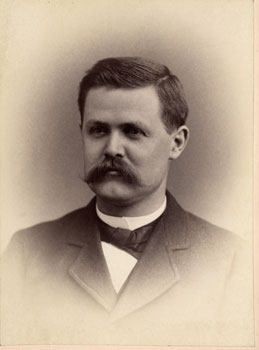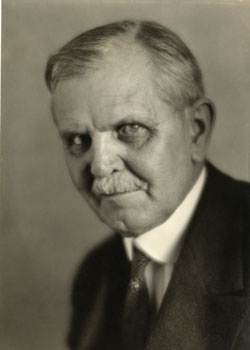Skating on Caleb Mills' Pondby Beth Swift |
| Printer-friendly version | Email this article |
|
Two of the College's most celebrated scientists were born in China John and Stanley’s maternal grandfather was John Finley Crowe, a Presbyterian minister, founder of Hanover College, and an ardent abolitionist. There are many old ties between Hanover and Wabash—in fact, the man who donated the land for our first campus was also a member of the Hanover board of trustees. Caroline Crowe Coulter was the 10th of 12 children and she was raised on the campus of Hanover. Moses Coulter was from western Virginia and quite poor. He came to Hanover in 1844 and worked his way through college as a barrel maker. After graduation in 1848, Moses married Caroline, and a year later the young couple was off to Ningbo, China, on missionary work. When Moses died suddenly, Caroline found herself a single mother in a foreign land and pregnant with her second son. Undaunted, she continued the mission work for another two years before heading home by sea with her sons, a Chinese nurse, and a goat to provide on-board milk for the boys. Caroline secured a teaching position at a prep school in Waveland, Indiana, and her brother was the minister of the First Presbyterian Church here in Crawfordsville. When he decided to open a day school at the church, Caroline was hired as a teacher. Both of her boys worked as janitors for the church, and while the family lived in Crawfordsville, Stanley attended Wabash Preparatory while John went off to Hanover. A biography of Stanley, written by John’s son, notes that Stanley’s favorite thing to do at school was ice skate on Caleb Mills’ pond. John Merle Coulter trained as a geologist, but his adventures as a member of the Hayden Expeditions to Yellowstone and the Rockies led him to a love of botany. He traveled to the East Coast to work on the botanical samples he had collected. This work led to a connection with Asa Grey of Harvard, pre-eminent among botanists in America. In 1879 John came to Wabash. He brought an advanced view of the sciences to the College, including a strong belief in evolution. He immediately lobbied for better storage for the collections of the science department—a herbarium and many geological specimens. Through his determined efforts the old gymnasium was renovated and transformed into the Hovey Museum. In addition to his heavy teaching load, John Merle Coulter founded the Botanical Gazette as a way to spread and share information on botany in a timely and scholarly fashion across the nation. Professor Coulter was immensely popular on campus. The College magazines of the day are full of students’ praise for his good work as a professor. Many hoped that he might become the next president after Tuttle retired. So in 1891 John moved to Bloomington to become president of Indiana University. He found the life of a large state university too busy to pursue his first love, botanical research. He left Indiana for the presidency of Lake Forest College in Chicago, which proved to be much the same situation—constant fundraising with little or no time to follow his passion for botany. Three years later, John went to the University of Chicago as chair of the Department of Botany. John retired from Chicago in 1925 and died in 1928, a well-known and major contributor to the field of botany in America. Stanley graduated from Hanover, and his first posting was in Logansport, IN, where he was the principal of the local high school. It was here that he met and married Lucy Post (daughter of Wabash founder Martin M. Post). In 1885 Stanley was called to the presidency of Coates College in Terre Haute. Two years later he came to Purdue, where his career was of such substance that the first building at Purdue to bear the name of any person was Stanley Coulter Hall. In addition to building Purdue into a science powerhouse, Stanley was a founding member of the Indiana Academy of Science and was instrumental in establishing Turkey Run as our second state park. The Coulter brothers’ story is so much bigger than can be captured in this small piece, but their lives are so closely entwined with Wabash that I felt I should not miss this chance to share a bit about these boys, their strong mother, and their ties to China—the country on which the College is refocusing through its Asian Studies and The Liberal Arts program. —Beth Swift, Archivist
Top Photo: John Merle Coulter
|

 When I heard that this issue was to have an Asian focus, my first thoughts were of the Coulter brothers, John Merle and Stanley. The first was a revered member of our historic faculty and the second an alumnus of the prep school, and both were born in China, the children of missionaries.
When I heard that this issue was to have an Asian focus, my first thoughts were of the Coulter brothers, John Merle and Stanley. The first was a revered member of our historic faculty and the second an alumnus of the prep school, and both were born in China, the children of missionaries. It was not to be; instead, Wabash stuck to its tradition of hiring ministers to lead the College.
It was not to be; instead, Wabash stuck to its tradition of hiring ministers to lead the College.